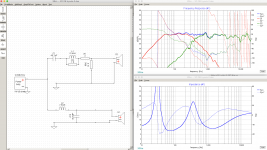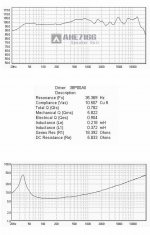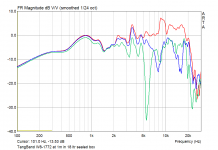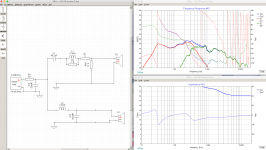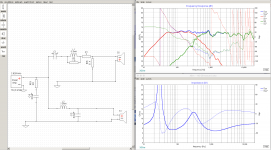like I said, it looks good and probably would sound good as is.
IMO - it would sound better to get that woofer out of the way faster and go 2nd order, by adding a Capacitor to ground after the coil and see what that gets you. You might be able to lower that coil a little and save some cash, since Caps are much less.
Also, this would allow you to move the F-R lower and get more use out of it crossing right after the baffle-step, or about 500-800Hz.
Both of these will change your phase and should get your XO point and the 90-degree phase switch (200-300Hz currently) closer together which will just be that much better.
Doing good for your first try at this.
IMO - it would sound better to get that woofer out of the way faster and go 2nd order, by adding a Capacitor to ground after the coil and see what that gets you. You might be able to lower that coil a little and save some cash, since Caps are much less.
Also, this would allow you to move the F-R lower and get more use out of it crossing right after the baffle-step, or about 500-800Hz.
Both of these will change your phase and should get your XO point and the 90-degree phase switch (200-300Hz currently) closer together which will just be that much better.
Doing good for your first try at this.
Thank you for the feedback.
Here's the plot, with individual driver and phase, plus overall FR.
Looks like phase curves for individual drivers is not minimum phase that follow actual amplitude, that could be because they not zero aligned before exported as frd file or because of non minimum phase acoustic interference. Am i wrong here or is it because you tweaked "mod delay" that phase lag the higher the frq goes.
Looks like phase curves for individual drivers is not minimum phase that follow actual amplitude, that could be because they not zero aligned before exported as frd file or because of non minimum phase acoustic interference. Am i wrong here or is it because you tweaked "mod delay" that phase lag the higher the frq goes.
Hello BYRTT,
I didn't adjust anything when I recorded the sweeps, one for the 15" driver, one for the 8" full range, with REW. Both driver set on my open baffle setup. I set the preamp at exactly the same for both sweeps and never touched anything in REW, only exported as recorded.
Hello BYRTT,
I didn't adjust anything when I recorded the sweeps, one for the 15" driver, one for the 8" full range, with REW. Both driver set on my open baffle setup. I set the preamp at exactly the same for both sweeps and never touched anything in REW, only exported as recorded.
Okay then if your "Preference/Analysis/Impulse Response Calculation" is set to "No timing reference" we can't use phase curves to steer drivers cooperation, only amplitude curves is useful then, suggest before export use "Estimate IR Delay" or tweak IR manual to get useful minimum phase curves.
In bed now,
I will have a look at REW settings tomorrow.
I did have the Timing Refrerence box checked when I made the sweeps, in the Measure window. Is that the one you are talking about?
Sleep well : ) its the meny where to pick between "No timing reference / Use loopback as timing reference / Use acoustic timing reference".
If set as first point then no multiple sweep will be exactly same precise timing and IR has to be corrected manual or with "Estimate IR Delay" button, for point two and three multiple sweeps would be precise relative to each other but these features need further hardware in form of loopback cable or acoustic tweeter.
Ok, I found the menu. It was set at Use acoustic timing reference.
The drivers are the AHE 38P00A 15" driver (a locally made driver)
ÅS¤Ñ©ç½æ-¥xÆW NO.1 ©ç½æºô¯¸
And the TB W8-1772 (but TB is famous for letting their marketing department draw the FR line)
The drivers are the AHE 38P00A 15" driver (a locally made driver)
ÅS¤Ñ©ç½æ-¥xÆW NO.1 ©ç½æºô¯¸
And the TB W8-1772 (but TB is famous for letting their marketing department draw the FR line)
Attachments
If you want to make the impedance look nicer, just put a 20ohm 20W resistor in series with about 20uF of capacitor, and put those across the crossover input (amp output) terminals. Wastes a little power but won't affect sensitivity. Probably not worthwhile though, unless the speaker is used with a high output impedance amp (like a SET, Zen, or some low feedback tube types).
If you want to make the impedance look nicer, just put a 20ohm 20W resistor in series with about 20uF of capacitor, and put those across the crossover input (amp output) terminals. Wastes a little power but won't affect sensitivity. Probably not worthwhile though, unless the speaker is used with a high output impedance amp (like a SET, Zen, or some low feedback tube types).
Hmmm... that didn't work so well. See picture.
My amp is the NuPrime MCH-K38, and they don't mention output impedance anywhere, only input impedance at 47k Ohms. But, they call it a class A/D amp, so, I think I'm fine with it.
Attachments
Hmmm... that didn't work so well. See picture.
.
No, no, no. Don't put a network between the crossover and the amp -- put the speaker back where it was and THEN put a resistor and capacitor (which are in series with each other) with one lead to crossover input[+] and the other to crossover input [-]. You want to shunt the speaker impedance with the series RC impedance.
REW. Free.
Need a mic for the frd, need a resistor for the zma.
zma/impedance is a bit harder with building a little circuit, so, I just got DATS that will export zma files easily at the click of the mouse.
Very good. Appreciate the response.
What does REW and DATS stand for so I can find these?
I have X-sim loaded and working. I input a known network diagram and known zma frd files for Altec duplex drivers and it works well. But doesn't match the particular drivers I have so would like to measure mine.
Ron
Told you this was my first time!
Ok, I think I got what you said. It moves the second impedance peak down by about 5 Ohms, and lowers it from 350Hz to 300Hz.
Or, more simply, it throws some dissipation and yanks everything down from about 300Hz and up. You might want to make the cap bigger (maybe 33uF or 47uF?) to get the lower midrange peak down a little further. Not so low that it gets into the bass, though. (But again, if you're using a high damping factor amp, probably don't use the network at all
Thanks!
Ron
Or, more simply, it throws some dissipation and yanks everything down from about 300Hz and up. You might want to make the cap bigger (maybe 33uF or 47uF?) to get the lower midrange peak down a little further. Not so low that it gets into the bass, though. (But again, if you're using a high damping factor amp, probably don't use the network at all)
I did try to change the values a bit, and best I got was a 20 Ohms resistor and a 40uf cap.
My amp has a damping factor of 400. So, I might not need it, but thanks anyway. It's all part of the learning process!
- Home
- Design & Build
- Software Tools
- XSim free crossover designer
